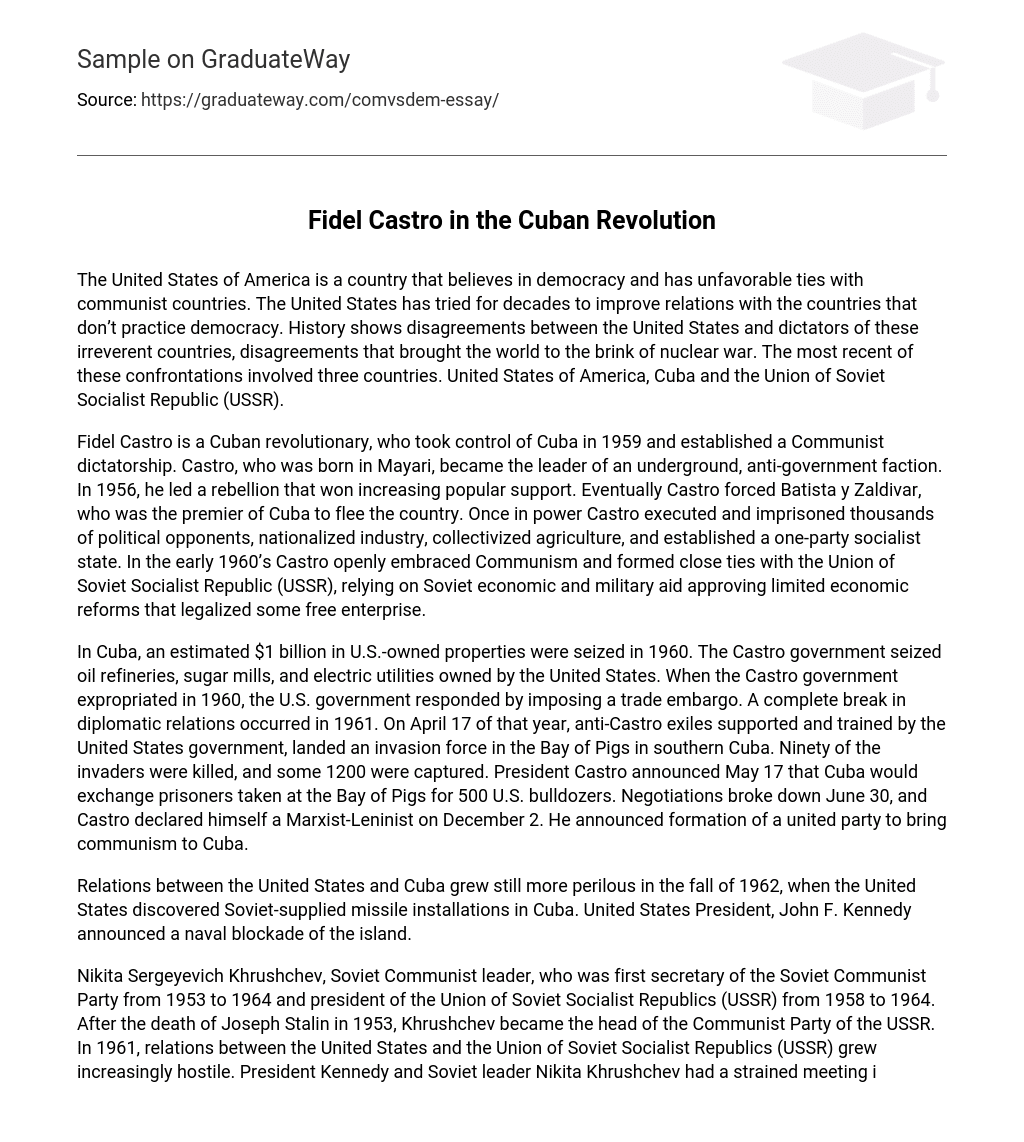The United States of America is a country that believes in democracy and has unfavorable ties with communist countries. The United States has tried for decades to improve relations with the countries that don’t practice democracy. History shows disagreements between the United States and dictators of these irreverent countries, disagreements that brought the world to the brink of nuclear war. The most recent of these confrontations involved three countries. United States of America, Cuba and the Union of Soviet Socialist Republic (USSR).
Fidel Castro is a Cuban revolutionary, who took control of Cuba in 1959 and established a Communist dictatorship. Castro, who was born in Mayari, became the leader of an underground, anti-government faction. In 1956, he led a rebellion that won increasing popular support. Eventually Castro forced Batista y Zaldivar, who was the premier of Cuba to flee the country. Once in power Castro executed and imprisoned thousands of political opponents, nationalized industry, collectivized agriculture, and established a one-party socialist state. In the early 1960’s Castro openly embraced Communism and formed close ties with the Union of Soviet Socialist Republic (USSR), relying on Soviet economic and military aid approving limited economic reforms that legalized some free enterprise.
In Cuba, an estimated $1 billion in U.S.-owned properties were seized in 1960. The Castro government seized oil refineries, sugar mills, and electric utilities owned by the United States. When the Castro government expropriated in 1960, the U.S. government responded by imposing a trade embargo. A complete break in diplomatic relations occurred in 1961. On April 17 of that year, anti-Castro exiles supported and trained by the United States government, landed an invasion force in the Bay of Pigs in southern Cuba. Ninety of the invaders were killed, and some 1200 were captured. President Castro announced May 17 that Cuba would exchange prisoners taken at the Bay of Pigs for 500 U.S. bulldozers. Negotiations broke down June 30, and Castro declared himself a Marxist-Leninist on December 2. He announced formation of a united party to bring communism to Cuba.
Relations between the United States and Cuba grew still more perilous in the fall of 1962, when the United States discovered Soviet-supplied missile installations in Cuba. United States President, John F. Kennedy announced a naval blockade of the island.
Nikita Sergeyevich Khrushchev, Soviet Communist leader, who was first secretary of the Soviet Communist Party from 1953 to 1964 and president of the Union of Soviet Socialist Republics (USSR) from 1958 to 1964. After the death of Joseph Stalin in 1953, Khrushchev became the head of the Communist Party of the USSR. In 1961, relations between the United States and the Union of Soviet Socialist Republics (USSR) grew increasingly hostile. President Kennedy and Soviet leader Nikita Khrushchev had a strained meeting in Vienna, Austria. Later that year, the Communists in East Germany ordered a wall be built on the border between East and West Berlin. This would prevent East Germans from fleeing their country via West Berlin, which was under the control of the United States, France, and Great Britain. When East German soldiers began blocking the allied route through East Germany into Berlin, Kennedy sent in a force of 1500 soldiers, ending Communist interference.
Relations with the United States were tense because Khrushchev favored nuclear weapons over conventional armies. These tensions culminated during the Cuban Missile Crisis of 1962. The Cuban missile crisis in October produced a tense nuclear confrontation between Washington and Moscow. U.S. aerial surveillance discovered Soviet offensive missile and bomber bases in Cuba. President Kennedy ordered an air and sea “quarantine” of Cuba to prevent shipment of arms to Fidel Castro. President
Kennedy met with Soviet ambassador Dobrynin at his embassy and learned Moscow would agree to withdraw the missiles with their atomic warheads from Cuba if U.S. nuclear missiles are withdrawn from Turkey. President Kennedy rejected the deal when President Khrushchev offered it publicly, but U.S. General Lauris J. Norstad (who opposed quick removal of the 15 obsolescent Jupiter rockets from Turkey) was unexpectedly retired from his post as NATO commander. After several strained days, Khrushchev lost support from the KGB and the conservative members of the Communist Party when he denounced Stalin. He alienated the military by advocating defense based on nuclear weapons. Finally, Khrushchev agreed to dismantle the Cuban missile sites and remove them. Soon after the Cuban blockade ended, and the U.S. missiles in Turkey were quietly removed.
The United States also supported an unsuccessful attempt by Cuban exiles to overthrow Castro in 1961. Their plan was to move inland and join with anti-Castro forces to stage a revolt, but Castro’s forces defeated the exiles and took the survivors as prisoners. Castro demanded money for their release. Kennedy refused to negotiate directly with Castro, but at Kennedy’s urging businesses and private citizens reached an agreement with Castro. In 1962, 1113 prisoners were released in exchange for food and medical supplies valued at approximately $53 million.
Throughout the year’s there have been many conflicts between democratic policy makers and totalitarian communist ran countries. Conflicts that might have brought the world to an end. By far the Cuban Missile Crisis was the world’s closest approach to nuclear war.
encarta
history channel.com
encyclopedia.com





